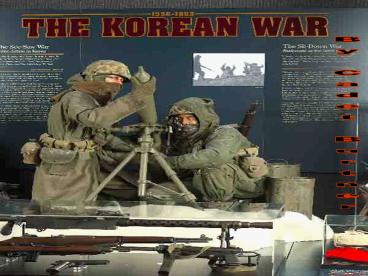By Cadet Burtner PowerPoint PPT Presentation
1 / 8
Title: By Cadet Burtner
1
By Cadet Burtner
2
- The Korean War (Korean ????), from June 25, 1950
to July 27, 1953, was a conflict between North
Korea and South Korea. It was also a Cold War
proxy war between the United States and its
United Nations allies and the Communist powers of
the People's Republic of China and the Soviet
Union (also a UN member nation). The principal
combatants were North and South Korea. Principal
allies of South Korea included the United States,
Canada, Australia, the United Kingdom, although
many other nations sent troops under the aegis of
the United Nations. Allies of North Korea
included the People's Republic of China, which
supplied military forces, and the Soviet Union,
which supplied combat advisors and aircraft
pilots, as well as arms, for the Chinese and
North Korean troops. In the United States, the
conflict was termed a police action (as the
Korean Conflict) under the aegis of the United
Nations rather than a war, largely in order to
remove the necessity of a Congressional
declaration of war.
3
June 25, 1950 North Korean forces moved south in
force. Using Soviet equipment and with huge
reserves of manpower, their surprise attack was a
devastating success. Within days South Korean
forces were in full retreat. Seoul was captured
by the North Koreans on June 28. Eventually the
South Korean forces, and the small number of
Americans in Korea, were driven into a small area
in the far South around the city of Pusan. With
the aid of American supplies and air support the
ROK (Republic of Korea) forces managed to
stabilize this frontier. This became a desperate
holding action called the Pusan Perimeter.
Although more UN support arrived, the situation
was dire, and looked as though the North could
gain control of the entire peninsula.
4
In 1950, North Korean and Chinese
Communist troops invaded South Korea. To prevent
the American ally from being completely overrun
and to check the spread of Communism in Asia,
President Truman immediately sent in General
Douglas MacArthur to command the United Nations
forces. The Korean War became the first in a
series of localized conflicts that punctuated the
Cold War.
5
600,000 Koreans died in the conflict according to
US estimates. The whole number, including all
civilians and military soldiers from UN Nations
and China, amount to the order of 2,000,000
deaths. More than a million South Koreans were
killed, 85 of them civilians. According to
figures published in the Soviet Union, 11.1 of
the total population of North Korea perished,
which indicates that 1,130,000 people were
killed. In sum, about 2,500,000 people were
killed, including north and south together
6
When the guns finally fell silent across the
Korean Peninsula on July 27, 1953, about 2
million people were dead, many more wounded, and
countless dislocated and separated from their
families. Ironically, all this occurred in a
three-year "police action". Now, 50 years later,
North Korea and the United States are "drifting
toward war, perhaps as early as this year", as
former US secretary of defense William Perry was
quoted in the Washington Post on July 15.
.
7
Built at a cost of 18 million in donated funds,
this powerful memorial, located on a 2.2-acre
site adjacent to the Lincoln Memorial Reflecting
Pool, features a sculptured column of 19 foot
soldiers arrayed for combat, with the American
flag as their symbolic objective. A 164-foot
mural wall is inscribed with the words, "Freedom
Is Not Free" and is etched with 2,500
photographic images of nurses, chaplains, crew
chiefs, mechanics and other support personnel to
symbolize the vast effort that sustained the
military
8
The End

